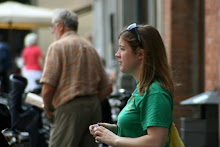Three things determine the exposure of your photograph.
- ISO = how sensitive the digital sensor is to the light. Typical ISO values include 100, 200, 400, 800, 1600, and 3200. A low ISO makes a "smoother" look; a high ISO can make a look with "digital noise." Use a lower ISO when possible; use a high ISO when it's dark out. Set the ISO when you first turn on the camera, then leave it alone unless the lighting situation changes.
- shutter speed = the amount of time that the inside shutter is lifted up, allowing the light to hit the digital sensor. Shutter speed is measured in fractions of a second; typical shutter speeds include 1, 2, 4, 8, 15, 30, 60, 125, 250, 500, 1000, 2000, and 4000. Setting the shutter speed on a higher number will reduce the shutter speed and capture the image more quickly, which is good if you want to capture a moving image without blur (as in sports photography). Setting the shutter speed on a lower number will increase the shutter speed and spend more time capturing the image, allowing for blur. Shutter speed also has a setting called "B" or "bulb" -- this means that as long as your finger is on the button that takes the photograph, the shutter will be open. This effect can be used for time-delay shots, nighttime shots, or double exposures.
- aperture = F-stop = the size of the inner hole in the camera that the light passes through during the exposure. The bigger the hole, the greater amount of light that will be allowed through. Typical aperture values include 1.4, 2, 2.8, 4, 5.6, 8, 11, 16, 22, 32. Smaller numbers indicate a larger aperture opening, and larger numbers indicate a smaller aperture opening. (Very counterintuitive.) The aperture controls depth-of-field -- the distance in front of the camera that will be captured in focus. A greater depth-of-field means that mostly everything will be in focus; a narrow depth-of-field means that only a small bit of your photograph will be in focus. If you shoot with a smaller aperture, you can capture something far away in focus. (Think of squinting at something far away -- you close the aperture of your eye in order to see farther.)
The light meter is a gauge to show whether or not enough light is coming in through the lens. If not enough light is entering the camera, your photo will be underexposed; if there is too much light, your photo will be overexposed. Adjust the combination of aperture and shutter speed in order to make the light meter fall at a neutral position -- this indicates that the amount of light is correct.
Focal length is a fancy term for "zoomed in/out." It is measured in millimeters and indicates how far the lens is from the digital sensor inside the camera. So, the higher the number (displayed on the lens itself), the more zoomed in the lens will be. The technical term for "zoomed out" is wide-angle; the technical term for "zoomed in" is telephoto. A wide-angle shot can distort perspective, and a telephoto shot makes a more "normal" image. A rule of thumb if you want natural shots is to set the lens to telephoto (zoomed in), and then move your body based on what you want to see in the frame.
White balance refers to the color temperature of the light entering the camera. For example, daylight and fluorescent lights have different color temperatures. Adjust the white balance depending on what sort of environment you're shooting in in order to produce more natural shots.
We also learned about histograms, exposure compensation, focus area, and metering, but they're rather difficult to explain without being able to demonstrate on a digital camera. All in all, a very productive day and definitely beneficial for my upcoming photography work.

No comments:
Post a Comment